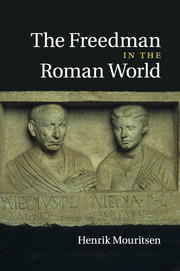Book contents
6 - The freedman in the Roman economy
Published online by Cambridge University Press: 21 January 2011
Summary
After the section on the practice of manumission, its frequency, modalities, and patterns, we will now turn to the place of the freedman in the Roman economy and society. The first of these chapters is devoted to their role in the economy, which has attracted much scholarly attention. The reason is partly the sheer abundance of evidence for their participation in the economy, especially the urban commercial sector, which they seem to dominate completely, and partly the phenomenon of the rich freedman. This issue will be dealt with separately in the second part of the chapter, but a brief survey of some of the evidence for freedmen in urban trade and manufacture may be useful.
Not all the evidence that has been adduced in this context is equally compelling; for example, the many funerary inscriptions with job titles may not be representative, since this medium was used only sporadically outside the freedman community. But many other types of sources were not the result of the freedmen's epigraphic ‘habit’. Thus, amphorae and other types of containers carry inscriptions indicating the producers and recipients of the contents, and here the majority of the names appear to be those of freedmen and slaves. Similarly, pottery was stamped with the names of the producers, who often seem to be ‘servile’. At Pompeii a number of seal stamps have been found which were used to mark a variety of products, and at least two thirds of them may feature freedmen.
- Type
- Chapter
- Information
- The Freedman in the Roman World , pp. 206 - 247Publisher: Cambridge University PressPrint publication year: 2011



